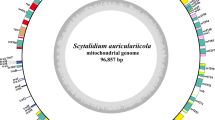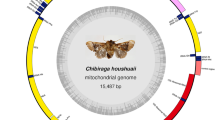Abstract
The complete nucleotide sequence of the mitogenome of Bombyx mandarina strain Qingzhou was determined. The circular genome is 15,717 bp long and has the typical gene organization and order of lepidopteran mitogenomes. All protein-coding sequences are initiated with a typical ATN codon, except the COI gene, which has a 4-bp TTAG putative initiator codon. Eleven of the 13 protein-coding gene have a complete termination codon (all TAA), but the remaining two genes terminate with incomplete codons. All transfer RNAs (tRNAs) have a clover-leaf structure typical of the mitochondrial tRNAs, and some of them have a mismatch in the four-stem-and-loop structure. The length of the A + T rich region of B. mandarina strain Qingzhou is 495 bp, shorter than that of B. mandarina strain Tsukuba (747 bp) but similar to that of Bombyx mori. Phylogenetic analysis based on the whole mitochondrial genome sequences of the available sequenced species (B. mori strains C-108, Aojuku, Backokjam, and Xiafang, B. mandarina strains Tsukuba, Ankang, and Qingzhou, and Antheraea pernyi) shows the origin of the domesticated silkmoth B. mori to be the Chinese B. mandarina. Nuclear mitochondrial pseudogene sequences were detected in the nuclear genome of B. mori with the MEGA BLAST search program. A phylogenetic analysis of these nuclear mitochondrial pseudogene sequences suggests that B. mori was domesticated independently in different areas and periods.


Similar content being viewed by others
References
Arunkumar KP, Muralidhar M, Nagaraju J (2006) Molecular phylogeny of silk moths reveals the origin of domesticated silk moth, Bombyx mori from Chinese Bombyx mandarina and paternal inheritance of Antheraea proylei mitochondrial DNA. Mol Phylogen Evol 40:419–427
Banno Y, Nakamura T, Nagashima E, Fujii H, Doira H (2004) M chromosome of the wild silkworm, Bombyx mandarina (n = 27), corresponds to two chromosomes in the domesticated silkworm, Bombyx mori (n = 28). Genome 47:96–101
Beard CB, Mills D, Collins FH (1993) The mitochondrial genome of the mosquito Anopheles gambiae: DNA sequence, genome organization, and comparisons with mitochondrial sequences of other insects. Insect Mol Biol 2:103–124
Bensasson D, Zhang DX, Hartl DL, Hewitt GM (2001) Mitochondrial pseudogenes: evolution’s misplaced witnesses. Trends Ecol Evol 16:314–321
Bibb MJ, Van Etten RA, Wright CT, Walberg MW, Clayton DA (1981) Sequence and gene organization of mouse mitochondrial DNA. Cell 26:167–180
Boore JL (1999) Animal mitochondrial genomes. Nucleic Acids Res 27:1767–1780
Boyce TM, Zwick ME, Aquadro CF (1989) Mitochondrial DNA in the bark weevils: size, structure and heteroplasmy. Genetics 123:825–836
Brehm A, Harris DJ, Hernandez M, Cabrera V, Larruga J, Pinto F, Gonzalez AM (2001) Structure and evolution of the mitochondrial DNA complete control region in the Drosophila subobscura subgroup. Insect Mol Biol 10:573–578
Cameron SL, Whiting MF (2008) The complete mitochondrial genome of the tobacco hornworm, Manduca sexta (Insecta: Lepidoptera: Sphingidae), and an examination of mitochondrial gene variability within butterflies and moths. Gene 408:112–123
Cha SY, Yoon HJ, Lee EM, Yoon MH, Hwang JS, Jin BR, Han YS, Kim I (2007) The complete nucleotide sequence and gene organization of the mitochondrial genome of the bumblebee, Bombus ignitus (Hymenoptera: Apidae). Gene 392:206–220
Clary DO, Wolstenholme DR (1985) The mitochondrial DNA molecule of Drosophila yakuba: nucleotide sequence, gene organization, and genetic code. J Mol Evol 22:252–271
Clary DO, Wolstenholme DR (1987) Drosophila mitochondrial DNA: conserved sequences in the A + T-rich region and supporting evidence for a secondary structure model of the small ribosomal RNA. J Mol Evol 25:116–125
Coates BS, Sumerford DV, Hellmich RL, Lewis LC (2005) Partial mitochondrial genome sequences of Ostrinia nubilalis and Ostrinia furnicalis. Int J Biol Sci 1:13–18
Crozier RH, Crozier YC (1993) The mitochondrial genome of the honeybee Apis mellifera: complete sequence and genome organization. Genetics 133:97–117
Dotson EM, Beard CB (2001) Sequence and organization of the mitochondrial genome of the Chagas disease vector, Triatoma dimidiata. Insect Mol Biol 10:205–215
Fu YX, Li WH (1997) Estimating the age of the common ancestor of a sample of DNA sequences. Mol Biol Evol 14:195–199
Gamo T, Ohtsuka Y (1980) Phylogenetic studies on the racial differentiation of the silkworm, Bombyx mori, on the basis of polymorphic genes in haemolymph proteins. Bull Sericul Exp Sta 28:15–50
Gray MW (1989) Origin and evolution of mitochondrial DNA. Annu Rev Cell Biol 5:25–50
Hajibabaei M, Janzen DH, Burns JM, Hallwachs W, Hebert PDN (2006) DNA barcodes distinguish species of tropical Lepidoptera. Proc Natl Acad Sci USA 103:968–971
Hemudu Relics Archaeological Team (1980) Main discoveries of the second excavation of Hemudu sites in Zhejiang. Cult Relics 5:1
Inohira K, Hara T, Matsuura ET (1997) Nucleotide sequence divergence in the A + T-rich region of mitochondrial DNA in Drosophila simulans and Drosophila mauritiana. Mol Biol Evol 14:814–822
Jiang YL (1982) The origin and differentiation of domesticated silkworms. Jiangsu Scientific and Technical Press, Nanjing
Junqueira AC, Lessinger AC, Torres TT, da Silva FR, Vettore AL, Arruda P, Azeredo-Espin AM (2004) The mitochondrial genome of the blowfly Chrysomya chloropyga (Diptera: Calliphoridae). Gene 339:7–15
Kawaguchi E (1934) Chromosome behaviour in tetraploid female of the silkworm. J Sericult Sci Jpn 5:73–79 (in Japanese)
Kim I, Phillips CJ, Monjeau JA, Birney EC, Noack K, Pumo DE (1998) Habitat islands, genetic diversity, and gene flow in a Patagonian rodent. Mol Ecol 7:667–678
Kim I, Bae JS, Sohn HD, Kang PD, Ryu KS, Sohn BH et al (2000) Genetic homogeneity in the domestic silkworm, Bombyx mori, and phylogenetic relationship between B. mori and the wild silkworm, B. mandarina using mitochondrial COI gene sequences. Int J Indust Entomol 1:9–17
Kim I, Lee EM, Seol KY, Yun EY, Lee YB, Hwang JS, Jin BR (2006) The mitochondrial genome of the Korean hairstreak, Coreana raphaelis (Lepidoptera: Lycaenidae). Insect Mol Biol 15:217–225
Kumar S, Tamura K, Nei M (2004) MEGA3: integrated software for molecular evolutionary genetics analysis and sequence alignment. Brief Bioinform 2:150–163
Lavrov DV, Brown WM, Boore JL (2000) A novel type of RNA editing occurs in the mitochondrial tRNAs of the centipede Lithobius forficatus. Proc Natl Acad Sci USA 97:13738–13742
Lee ES, Shin KS, Kim MS, Park H, Cho S, Kim CB (2006) The mitochondrial genome of the smaller tea tortrix Adoxophyes honmai (Lepidoptera: Tortricidae). Gene 373:52–57
Li A, Zhao Q, Tang S, Zhang Z, Pan S, Shen G (2005) Molecular phylogeny of the domesticated silkworm, Bombyx mori, based on the sequences of mitochondrial cytochrome b genes. J Genet 84:137–142
Liu Y, Li Y, Pan M, Dai F, Zhu X, Lu C, Xiang Z (2008) The complete mitochondrial genome of the Chinese oak silkmoth, Antheraea pernyi (Lepidoptera: Saturniidae). Acta Biochim Biophys Sin 40:693–703
Lu C, Yu HS, Xiang ZH (2002) Molecular systematic studies on Chinese Mandarina silkworm (Bombyx mandarina M.) and domestic silkworm (Bombyx mori L.). Sci Agri Sinica 35:94–101 (in Chinese)
Maekawa H, Takada N, Mikitani K, Ogura T, Miyajima N, Fujiwara H, Kobayashi M, Ninaki O (1988) Nucleolus organizers in the wild silkworm Bombyx mandarina and the domesticated silkworm B. mori. Chromosoma (Historical Archive) 96:263–269
Minato M (1966) The last viaduct of Japan Islands. Earth Sci 85(86):2–11 (in Japanese with English summary)
Monforte A, Barrio E, Latorre A (1993) Characterization of the length polymorphism in the A + T-rich region of the Drosophila obscura group species. J Mol Evol 36:214–223
Moritz C, Dowling TE, Brown WM (1987) Evolution of animal mitochondrial DNA: relevance for population biology and systematics. Annu Rev Ecol Syst 18:269–292
Murakami A, Imai HT (1974) Cytological evidence for holocentric chromosomes of the silkworms, Bombyx mori and B. mandarina (Bombycidae, Lepidoptera). Chromosoma 47:167–178
Negrisolo E, Minelli A, Valle G (2004) Extensive gene order rearrangement in the mitochondrial genome of the centipede Scutigera coleoptrata. J Mol Evol 58:413–423
Ojala D, Montoya J, Attardi G (1981) tRNA punctuation model of RNA processing in human mitochondria. Nature 290:470–474
Pan MH, Yu QY, Xia YL, Dai FY, Liu YQ, Lu C, Zhang Z, Xiang ZH (2008) Characterization of mitochondrial genome of Chinese wild mulberry silkworm, Bombyx mandarina (Lepidoptera: Bombycidae). Life Sci 51:693–701
Perna NT, Kocher TD (1995) Patterns of nucleotide composition at fourfold degenerate sites of animal mitochondrial genomes. J Mol Evol 41:353–358
Rand DM, Harrison RG (1989) Molecular population genetics of mtDNA size variation in crickets. Genetics 121:551–569
Salvato P, Simonato M, Battisti A, Negrisolo E (2008) The complete mitochondrial genome of the bag-shelter moth Ochrogaster lunifer (Lepidoptera, Notodontidae). Genomics 9:1–15
Sambrook J, Fritsch EF, Maniatis T (1989) Molecular cloning, a laboratory manual, 2nd edn. Cold Spring Harbor Laboratory Press, Woodbury, NY
Sankoff D, Leduc G, Antoine N, Paquin B, Lang BF, Cedergren R (1992) Gene order comparisons for phylogenetic inference: evolution of the mitochondrial genome. Proc Natl Acad Sci USA 89:6575–6579
Schultheis AS, Weigt LA, Hendricks AC (2002) Arrangement and structural conservation of the mitochondrial control region of two species of Plecoptera: utility of tandem repeat-containing regions in studies of population genetics and evolutionary history. Insect Mol Biol 11:605–610
Thompson JD, Gibson TJ, Plewniak F, Jeanmougin F, Higgins DG (1997) The CLUSTAL_X windows interface: flexible strategies for multiple sequence alignment aided by quality analysis tools. Nucleic Acids Res 25:4876–4882
Wolstenholme DR (1992) Animal mitochondrial DNA: structure and evolution. Int Rev Cyt 141:173–216
Wolstenholme DR, Clary DO (1985) Sequence evolution of Drosophila mitochondrial DNA. Genetics 109:725–744
Yagi T, Katoh T, Chichvarkhin A, Shinkawa T, Omoto K (2001) Molecular phylogeny of butterflies Parnassius glacialis and P. stubbendorfii at various localities in East Asia. Genes Genet Syst 76:229–234
Yamauchi Y, HoeVer C, Yamamoto A, Takeda H, Ishihara R, Maekawa H, Sato R, Su-Il S, Sumida M, Wells MA, Tsuchida K (2000) cDNA and deduced amino acid sequences of apolipophorin-IIIs from Bombyx mori and Bombyx mandarina. Arch Insect Biochem Physiol 43:16–21
Yoshitake N (1967) Phylogenetic aspects on the origin of Japanese race of the silkworm, Bombyx mori. J Sericult Sci Jpn 37:83–87
Yoshitake N (1968) Phylogenetic aspects on the origin of Japanese race of the silkworm, Bombyx mori L. J Sericult Sci Jpn 37:83–87
Yoshitake N, Akiyama M (1965) Distribution of the blood esterase types in various strains of the silkworm, Bombyx mori. J Sericult Sci Jpn 34:99–103
Yukuhiro K, Sezutsu H, Itoh M, Shimizu K, Banno Y (2002) Significant levels of sequence divergence and gene rearrangements have occurred between the mitochondrial genomes of the wild mulberry silkmoth, Bombyx mandarina, and its close relative, the domesticated silkmoth, Bombyx mori. Mol Biol Evol 19:1385–1389
Zakharov EV, Caterino MS, Sperling FA (2004) Molecular phylogeny, historical biogeography, and divergence time estimates for swallowtail butterflies of the genus Papilio (Lepidoptera: Papilionidae). Syst Biol 53:193–215
Zhang DX, Hewitt GM (1996) Nuclear integrations: challenges for mitochondrial DNA markers. Trends Ecol Evol 11:247–251
Zhang DX, Hewitt GM (1997) Insect mitochondrial control region: a review of its structure, evolution and usefulness in evolutionary studies. Biochem Syst Evol 25:99–120
Zhang D, Szymura JM, Hewitt GM (1995) Evolution and structural conservation of the control region of insect mitochondrial DNA. J Mol Evol 40:382–391
Acknowledgments
We gratefully acknowledge the financial support of the National Natural Science Foundation of China (30571404, 30671590), the National High Technology Research and Development Program of China (863 Program, 2006AA10A119), and the National Basic Research Program of China (973 Program, 2005CB121000).
Author information
Authors and Affiliations
Corresponding author
Additional information
Xiao-long Hu and Guang-li Cao contributed equally to this work.
Electronic supplementary material
Rights and permissions
About this article
Cite this article
Hu, Xl., Cao, Gl., Xue, Ry. et al. The complete mitogenome and phylogenetic analysis of Bombyx mandarina strain Qingzhou. Mol Biol Rep 37, 2599–2608 (2010). https://doi.org/10.1007/s11033-009-9781-2
Received:
Accepted:
Published:
Issue Date:
DOI: https://doi.org/10.1007/s11033-009-9781-2




